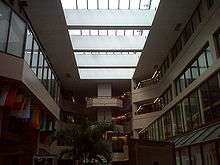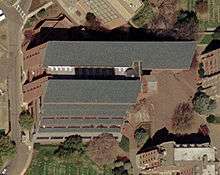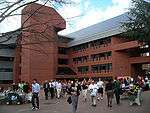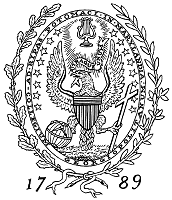Edward B. Bunn S.J. Intercultural Center
| The Edward B. Bunn S.J. Intercultural Center | |
|---|---|
| The Intercultural Center | |
|
Eastern entrance | |
| Alternative names | The ICC |
| General information | |
| Type | Administrative office |
| Architectural style | Contemporary |
| Address | 37th and O Streets NW, Washington, DC 20057 |
| Coordinates | 38°54′32″N 77°04′24″W / 38.90880°N 77.07336°W |
| Construction started | 1980 |
| Completed | May 1982 |
| Cost | $33,000,000 |
| Client | Georgetown University |
| Technical details | |
| Floor count | 7 |
| Floor area | 226,000 square feet (21,000 m2) |
| Design and construction | |
| Architecture firm | Metcalf & Associates[1] |
| Structural engineer | MMP International Inc. |
| Main contractor | The George Hyman Construction Co. |
The Edward B. Bunn S.J. Intercultural Center commonly known as the Intercultural Center or ICC is a seven-story mixed use building on the main campus of Georgetown University. The center was built in 1982 as the Photovoltaic Higher Education National Exemplar Facility in conjunction with a grant from the U.S. Department of Energy.[2] The facility hosts numerous administrative offices, student facilities, and conference spaces, but is best known for its contribution to solar power development. Among the occupants of the building are the Edmund A. Walsh School of Foreign Service, the Center for Contemporary Arab Studies, the Prince Alwaleed Bin Talal Center for Muslim-Christian Understanding, and several departments of Georgetown College.[3]
History

In 1980 Georgetown University applied to the Department of Energy for a grant to fund the construction of an intercultural center that would showcase the potential use building integration of photovoltaic panels to produce electrical power.[4] While the Congressional funding for the solar panels came as a result of heightened awareness of energy issues following the 1973 oil embargo, the funding for the structure itself came as a result of Georgetown's goal of improving American education in foreign languages and international affairs, which was deemed deficient in the post-Vietnam era.[5] This was part of Georgetown's effort at the time to secure federal funding for model projects that could be replicated at other universities and institutions across the nation.[6]
Construction began in early 1980 and the building itself was completed in May 1982 at a cost of $23,000,000.[2] The interior of the building consists of six floors of educational space and a seventh maintenance floor, altogether totaling 226,000 square feet (21,000 m2). While at the time the center was considered futuristic, a "dark spaceship" on the historic campus, it has since become incorporated into the campus with its Red Square courtyard serving as a student gathering area.[7]
Solar panels
 Aerial view of the center. |
In its original plans it would have been the largest photovoltaic installation in the world and as completed was one of the largest ever constructed.[5][8] At its peak it produced 360,000 kilowatt-hours (1.3×109 kJ) per year of electrical power, however with age, its current generation is approximately 200,000 kilowatt-hours (720,000,000 kJ) per year, or 6% of the structure's needs.[9][10] Additionally, the solar panels that were installed used a rough glass that reduced efficiency, but prevented glare from affecting airplanes operating out of nearby Reagan National Airport.[8]
While it had been designed with the installation of solar panels in mind, they were not installed until late 1984 by the Solarex Corporation at a cost of approximately $10,000,000.[11] Solarex installed the 35,710 square feet (3,318 m2) of solar panels on the roof of the center facing south.[8] Solarex was later purchased by the Amoco oil company and sold in 1995 to the Enron energy company.[12] The center has been recognized as being ahead of its time in the promotion of renewable energy sources and for continuing to operate as designed, decades after its construction.[13]
References
| Wikimedia Commons has media related to Intercultural Center (Georgetown University). |
- ↑ "1982 WBC Craftsmanship Awards Winners". Washington Building Congress. Retrieved 2010-05-28.
- 1 2 Podbielski, V.; D. Shaff (April 1994). "The Photovoltaic Higher Education National Exemplar Facility (PHENEF)". Georgetown University. Archived from the original (PDF) on unknown. Retrieved 2010-07-26. Check date values in:
|archive-date=(help) - ↑ "Edward B. Bunn, S.J. Intercultural Center". Georgetown University. Retrieved 4 September 2016.
- ↑ Strong, Steven J. "A New Generation of Solar Architecture" (PDF). Solar Design Associates. Retrieved 2010-05-28.
- 1 2 O'Neill, Paul R.; Paul K. Williams (2003). "Toward a Third Century" (PDF). Georgetown University. Arcadia Publishing. Retrieved 2010-05-28.
- ↑ "Rev. Thomas Byron Collins, S.J." (PDF). Maryland Province. 2006-06-20. Retrieved 2010-05-28.
- ↑ Forgey, Benjamin (1988-11-19). "The Inside Story; A Look at Georgetown's New Leavey Center". Washington Post. Retrieved 2010-05-28.
- 1 2 3 McIntosh, Kerry (2004-03-23). "Intercultural Center Keeps Ahead of the Times". The Hoya. Retrieved 2010-05-28.
- ↑ "Carbon Footprint". Office of the Senior Vice President. 2008. Retrieved 2010-05-28.
- ↑ Dwulet, Andrew (2010-04-23). "Green Efforts Gain Momentum on Campus". The Hoya. Retrieved 2010-05-28.
- ↑ "Lighting the Way With Creation's Original Remedy". Reocities. Retrieved 2010-07-26.
- ↑ Southerland, Daniel (1995-01-30). "Preparing for Its Day in the Sun; Solarex Aims to Cut Production Costs and Market Solar Power to Utilities". Washington Post. Retrieved 2010-05-28.
- ↑ Brown, Erin (2003-04-25). "Congressional Approval of Solar Power Bill Proves ICC To Be Ahead of Its Time". The Hoya. Retrieved 2010-05-31.

